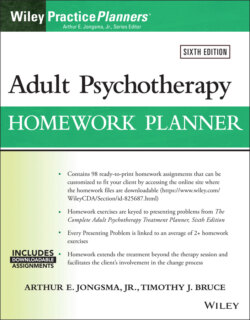Читать книгу Adult Psychotherapy Homework Planner - Arthur E. Jongsma Jr. - Страница 12
На сайте Литреса книга снята с продажи.
ОглавлениеINTRODUCTION
More and more therapists are assigning homework to their clients. Not only have short‐term therapy models endorsed this practice, but the benefits are being recognized by many traditional therapists as well.
WHY HOMEWORK?
Assigning homework to psychotherapy clients is beneficial for several reasons. With the advent of managed care, which often requires shorter and fewer treatment sessions, therapists assign between‐session homework to help maximize the effectiveness of briefer treatment. Homework is an extension of the treatment process, provides continuity, and allows the client to work between sessions on issues that are the focus of therapy. Homework is also a tool for more fully engaging the client in the treatment process. Assignments place more responsibility on the client to resolve presenting problems, counteracting the expectations that some clients may experience—that it is the therapist alone who can cure the client. For some, it even may bring a sense of self‐empowerment.
Another added benefit of homework is that these assignments give the client the opportunity to implement and evaluate insights or coping behaviors that have been discussed in therapy sessions. Practice often heightens awareness of various issues. Furthermore, homework increases the expectation for the client to follow through with making changes rather than just talking about change. Exercises require participation, which creates a sense that the client is taking active steps toward change. Homework allows the client to try new behaviors, bringing these experiences back to the next session for processing. Modifications can then be made to the client's thoughts, feelings, or behaviors as the homework is processed in the therapy session.
Occasionally treatment processes can become vague and abstract. By adding focus and structure, homework assignments can reenergize treatment. Moreover, homework can increase the client's motivation to change as it provides something specific to work on. Additionally, homework increases the involvement of family members and significant others in the client's treatment by using assignments that call for their participation. It promotes more efficient treatment by encouraging the client to actively develop insights, positive self‐talk, and coping behaviors between therapy sessions. Consequently, many clients express increased satisfaction with the treatment process when homework is given. They are empowered by doing something active that facilitates the change process, and it reinforces their sense of control over the problem. All of these advantages have made the assignment of therapeutic homework increasingly prevalent.
HOW TO USE THIS HOMEWORK PLANNER
Creating homework assignments and developing the printed forms for recording responses is a time‐consuming process. This Adult Psychotherapy Homework Planner, Sixth Edition, follows the lead of psychotherapeutic interventions suggested in The Complete Adult Psychotherapy Treatment Planner, Sixth Edition (Jongsma, Peterson, & Bruce, 2021) and provides a menu of homework assignments that can easily be photocopied. In addition to the printed format, the assignments in this Planner are provided online and accessible via a password for download after which they can be opened in WORD and customized to suit the client's individual needs or the therapist's approach or printed without change.
The assignments are grouped under presenting problems that are typical of those found in an adult population. These presenting problems are cross‐referenced to every presenting problem found in The Complete Adult Psychotherapy Treatment Planner. Although these assignments were created with a specific presenting problem in mind, don't feel locked in by a single problem‐oriented chapter when searching for an appropriate assignment. Included with each exercise is a cross‐referenced list of suggested presenting problems for which the assignment may be appropriate and useful called Additional Problems for Which This Exercise May Be Most Useful. This cross‐referenced list can assist you in applying the assignments to other situations that may be relevant to your client's particular presenting problem.
A broader cross‐referenced list of assignments is found in Appendix A, Alternate Assignments for Presenting Problems. Review this appendix to find relevant assignments beyond the one, two, three, or four exercises found in any specific presenting problem chapter. For example, under the heading of Depression—Unipolar in the appendix you will find 27 alternative assignments originally created for other presenting problems but relevant and easily adapted for use with a client struggling with depression issues. In this appendix, with every presenting problem are listed relevant additional assignments from throughout the book.
Remember, each assignment is available online and, therefore, can be quickly downloaded and edited for use with a specific client. This modified assignment can be saved on your computer's hard drive for repeated later use.
ABOUT THE ASSIGNMENTS
Therapists may introduce the homework assignment with varying degrees of detail and client preparation. Recommendations regarding this preparation and postexercise discussion are made on the title page of each assignment under the heading “Suggestions for Processing This Exercise with the Client.”
Clinical judgment must be used to choose the homework assignments that focus on relevant issues for the client. Each assignment contains a section on “Goals of the Exercise” to guide you in your selection of relevant homework for your client.
CARRYING OUT THE ASSIGNMENT
It is recommended that you review the entire book to familiarize yourself with the broad nature of the type and focus of the various homework exercises. Select a specific assignment from a chapter titled with your client's presenting problem or from the alternative list in the appendix and then review the list of homework goals. Assigning therapy homework is just a beginning step in the therapy treatment process. Carrying out the assignment requires a follow‐up exploration of the impact of the assignment on the client's thoughts, feelings, and behavior. What are the results? Was this assignment useful to the client? Can it be redesigned or altered for better results? Examine and search for new and creative ways to actively engage your client in participating in this homework process.
